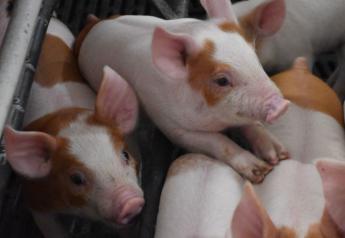NPPC 'Won’t Take No For An Answer' on Trade, Labor and FAD Prevention

The labor bottleneck isn’t improving for the U.S. pork industry. As pork prices continue to rise, Nick Giordano, National Pork Producers Council (NPPC) vice president and counsel for global government affairs, said the solution is simple.
“If we had more labor available on farms and in plants, we would have more pork to translate to lower consumer prices,” Giordano said in a media roundtable on April 7 during NPPC's Legislative Action Conference.
Food price inflation is a highly discussed topic, both around the country and in Washington, D.C., with elected officials and the current administration, he said.
“If we get more labor, we're going to have more pork and that's going to translate to lower prices,” Giordano said. “This is an extraordinarily important issue for our producers, and we're going to keep hammering it home.”
Giordano, along with NPPC staff and more than 100 U.S. pork producers, met with legislators this week to discuss three key issues impacting U.S. pork production: labor shortage, foreign animal disease (FAD) prevention and trade.
Is There an End to the Labor Nightmare?
NPPC President Terry Wolters, a Minnesota pig farmer, said the organization is urging senators and representatives to expand the H-2A visa program for year-round agricultural workers and packing plant workers.
“The pork industry depends on highly skilled positions, and it’s unfortunate when those workers come in and work for a short period of time. We spend a lot of time training them and then they have to go back,” Wolters said.
Although reactions were favorable for the most part to pork industry requests, Wolters said how labor programs will be adjusted and implemented remains a bit of a mystery at this point.
Giordano believes there are many policy makers on both sides of the aisle that understand prices are going up, due to factors outside of pork producers’ control.
“We have to play with the hand that we're dealt. We're less concentrated than we were five years ago, pork prices outside the United States are higher. There are 100 sectors of the economy that are more concentrated than meatpacking. Get us more labor. Let us increase our line speeds, you will see our prices go down. Let's work together on that,” he said.
It’s Time to Ramp Up FAD Prevention
After a deadly FAD, African swine fever (ASF), struck the Western Hemisphere for the first time in more than 40 years last July, pork producers are urging lawmakers to appropriate funds previously approved for support to National Animal Health Laboratory Network (NAHLN) labs for testing and surveillance of any foreign animal disease, not just ASF.
They also asked for funding to support USDA Animal and Plant Health Inspection Service (APHIS) to promote hiring of staff as well as support of U.S. Customs and Border Protection surveillance.
“Surveillance and protection from a foreign animal disease in this country is key. We're dependent on trade, and without that trade, our ag industry in general is in trouble,” Wolters said.
ASF dominates headlines, but Wolters reminded people that foot-and-mouth disease (FMD) is a critical disease or importance.
“In the last farm bill, we had approval for a vaccine for foot-and-mouth disease. FMD is a much broader disease that would encompass dairy and beef, so it's another key issue for us within the industry. Those prevention programs, as it relates to us being able to trade around the globe, are very important,” Wolters added.
U.S. Pork Industry Needs Expanded Trade Market
U.S. pork producers have benefited from more than 25% of its product being exported out of this country, to the tune of $8.1 billion in pork exports last year.
“It’s overwhelming when you think of trade challenges we’ve had with foreign countries,” Wolters said. “Along with the situation COVID presented over the past couple of years, an expanded trade market is beneficial to the industry.”
In 2021, U.S. pork producers captured $61 of export value per hog.
“We are asking Congress and urging the Biden administration to join back into the Comprehensive and Progressive Trans-Pacific Partnership (CPTPP) program,” Wolters said. “Those 11 countries in that trade bloc represent 500 million consumers and $13.5 trillion of GDP. Right now, having that as part of our toolbox is really important to pork producers.”
The U.S. has the ability to produce the most economically affordable food in the world and sharing that across the globe is very important, Wolters explained. He specifically noted the Indo-Pacific region including Australia, India, Japan, Philippines, South Korea, Singapore, Thailand and Vietnam.
“Exports are just absolutely critical to our industry, and the U.S. is the largest pork exporter in the world,” Giordano added.
A Great Story to Tell
The pork industry has a great story to tell, with over 100,000 U.S. jobs being directly tied to U.S. pork exports, said Maria Zieba, NPPC vice president of international affairs.
“When we're talking about U.S. job creation, this is part of the story. The U.S. pork industry and U.S. agriculture as a whole employ a tremendous number of people. We have the opportunity to continue to expand,” Zieba said. “I strongly encourage the administration to negotiate FTAs for the betterment of all of us.”
Giordano said it’s probably no surprise that the single biggest detriment to this industry would be going positive on ASF, and the single biggest opportunity is to get back in CPTPP and for the U.S. to “get back in the FTA business.”
“We fully understand the political dialogue and the constraints here, but for this sector, and I think for many more, access in foreign markets is critically important,” Giordano said. “It's going to remain at the top of the list. We're going to continue to aggressively talk about the importance of opening foreign markets.”
More from Farm Journal's PORK:







